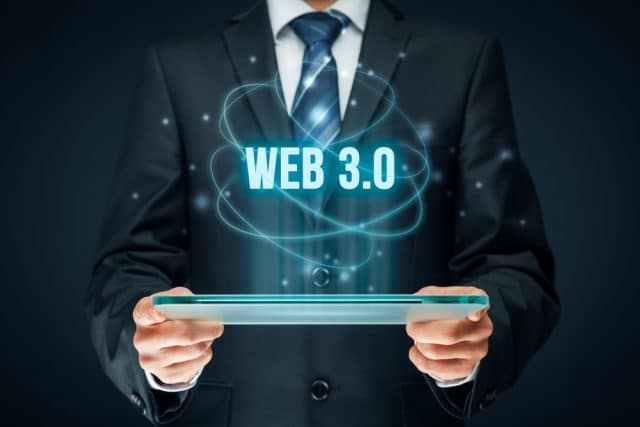Web 3.0 is upon us -- and it's set to shake up the digital landscape

Since the arrival of Web 2.0 at the turn of the millennium, the internet has had an escalating impact on the way we go about our daily lives.
As Web 2.0 upgraded the earlier 'read/write' internet model to a medium that was altogether more interactive, we have seen social media platforms become ubiquitous. Little by little, these changes paved the way for the 'social web', with more user-generated content and information-sharing at users’ fingertips.
Now, Web 3.0 is set to take things to the next level. A term coined by New York Times reporter John Markoff back in 2006, this new iteration of the internet will bring a whole new host of features to the fore -- such as artificial intelligence, 3D graphics, distributed ledger technology and decentralized data networks -- meaning that users will be better-connected than ever.
So, what can we expect from the new 'semantic web', and how does it differ from earlier versions of the internet?
Web 3.0 will be a step closer to immersive interactions
Five years after Tim Berners-Lee, the inventor of the World Wide Web, released his paper on the 'Semantic Web', he offered some further clarification, defining his vision for Web 3.0:
People keep asking what Web 3.0 is. I think maybe when you've got an overlay of scalable vector graphics everything rippling and folding and looking misty on Web 2.0 and access to a semantic Web integrated across a huge space of data, you'll have access to an unbelievable data resource.
Although not quite the Semantic Web Berners-Lee had envisioned, Web 3.0 is often defined as an 'intelligent' internet. By using state-of-the-art machine learning, it aims to facilitate faster, more ubiquitous connectivity. Put simply, users can expect data collection to be even more pervasive than before -- where Web 2.0 previously gathered data in existing mediums, Web 3.0 will collect data more purposefully, and in whatever context necessary.
The result of this is that Web 3.0 will be designed to provide greater context and deeper understanding of every web page -- meaning that search engines, for example, will be able to interpret the context of all the content they index. Ultimately, this should make for a smoother user experience, and no doubt, marketers will be first in line to take advantage of these advances in information-gathering.
Likewise, the dawn of Web 3.0 will encompass other advances in artificial intelligence (AI) and virtual and augmented reality (VR and AR), allowing reality to collide with the virtual world in new and meaningful ways. Ever since its inception, the World Wide Web has been envisaged as a 3D space -- indeed, many have noted that most keywords relating to the internet are spatial, offering three-dimensional evocations, like 'portal', 'virtual', and 'navigation'.
Until recently, the Web 2.0 has existed mostly in a 2D, 'flat' context -- but now, things are changing, and the Web 3.0 will add a third dimension to the internet experience. Given the widespread use of videoconferencing tools and communication platforms over the past year or so, we can only expect these technologies to become even more crucial.
Blockchain technology will make way for a decentralized gateway
Years ago, Berners-Lee did not envisage the fact that internet heavyweights would govern the web, profiting and presiding over our data. Thankfully, Web 3.0 will mark a return to the original intent behind the World Wide Web, overhauling Web 2.0’s focus on centralization and surveillance.
In time, blockchain technologies and decentralized infrastructure will have a greater part to play, ensuring that individuals have a fair and rightful ownership of their data. With any luck, this transparency should displace the exploitative tactics of tech giants, allowing individuals to 'opt-in' when it comes to their time and information.
Imagining the impact of a new Web 3.0
We have already reflected upon the fact that newer technologies will allow individuals to restore the sanctity of their data and avoid the surveillance and exploitative data handling that we have all become so accustomed to, while enjoying a more ubiquitous World Wide Web. That said, individuals might be wondering what the long-term consequences will be, when these changes come into place.
In this regard, one area ripe for discussion is the fact that decentralized web environments will remove much of the threat that cyber risks currently pose, offering greater autonomy, self-sovereignty, and opportunities for collaboration. In particular, exciting developments within networks like Filecoin, which offers decentralized storage for some of humanity’s most important information, will enable users to store data safely and reliably. Undoubtedly next-gen technologies like these have the potential to restore user trust, offering organizations across the board the opportunity to collaborate and share information securely.
Although some of these advancements may seem lightyears away, early-stage applications of Web 3.0 have already arrived, and things are only set to get better. Ultimately, the future looks bright for the World Wide Web, and business leaders have much to look forward to.
Photo credit: Jirsak / Shutterstock

Chris Starkey is the founder and director of NexGen Cloud, which is on a mission to bring cheap affordable cloud computing to all. London-headquartered NexGen Cloud is working with Cudo Ventures to disrupt the cloud compute market. With data centre operations established in Sweden and Norway the company is able to deliver infrastructure-as-a-service cloud computing that is cheaper and greener than the mainstream providers. NexGen Cloud also provides opportunities for investors to access the cloud sector, giving them the chance to share in the growth of market sector by investing in compute power.